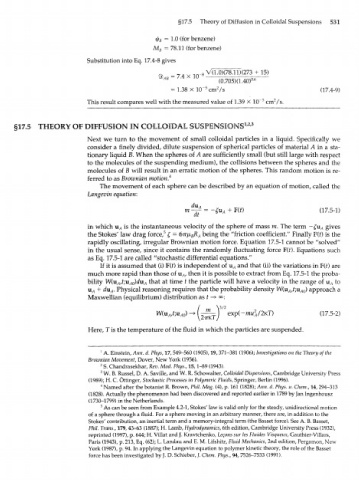Page 551 - Bird R.B. Transport phenomena
P. 551
§17.5 Theory of Diffusion in Colloidal Suspensions 531
ф = 1.0 (for benzene)
в
M =78.11 (for benzene)
B
Substitution into Eq. 17.4-8 gives
V(1.0)(78.11)(273 + 15)
8
^ - ? Л Х 1 ° (0.705)(1.40Г
5
2
= 1.38 X l(T cm /s (17.4-9)
2
Э
This result compares well with the measured value of 1.39 X 1СГ cm /s.
1 2 3
§17.5 THEORY OF DIFFUSION IN COLLOIDAL SUSPENSIONS ' '
Next we turn to the movement of small colloidal particles in a liquid. Specifically we
consider a finely divided, dilute suspension of spherical particles of material Л in a sta-
tionary liquid B. When the spheres of Л are sufficiently small (but still large with respect
to the molecules of the suspending medium), the collisions between the spheres and the
molecules of В will result in an erratic motion of the spheres. This random motion is re-
ferred to as Brownian motion. 4
The movement of each sphere can be described by an equation of motion, called the
Langevin equation:
m-jf= -£*A + W) (17.5-1)
in which u A is the instantaneous velocity of the sphere of mass m. The term -(u A gives
5
the Stokes' law drag force, £ = 6тгд К being the "friction coefficient/ 7 Finally F(£) is the
л
6
rapidly oscillating, irregular Brownian motion force. Equation 17.5-1 cannot be "solved"
in the usual sense, since it contains the randomly fluctuating force ¥(t). Equations such
as Eq. 17.5-1 are called "stochastic differential equations."
If it is assumed that (i) ¥(t) is independent of u A and that (ii) the variations in F(0 are
much more rapid than those of u A, then it is possible to extract from Eq. 17.5-1 the proba-
bility W(u A,t;u A0)du A that at time t the particle will have a velocity in the range of и to
л
u A + du . Physical reasoning requires that the probability density W(u ,t;u ) approach a
A0
A
A
Maxwellian (equilibrium) distribution as t -> °°:
( 2 ~ ) \з/2 ехр(-ти /2кТ) (175-2)
А
Here, T is the temperature of the fluid in which the particles are suspended.
1 A. Einstein, Ann. d. Phys, 17, 549-560 (1905), 19,371-381 (1906); Investigations on the Theory of the
Brownian Movement, Dover, New York (1956).
2 S. Chandrasekhar, Rev. Mod. Phys., 15,1-89 (1943),
3 W. B. Russel, D. A. Saville, and W. R. Schowalter, Colloidal Dispersions, Cambridge University Press
(1989); H. C. Ottinger, Stochastic Processes in Polymeric Fluids, Springer, Berlin (1996).
4 Named after the botanist R. Brown, Phil. Mag. (4), p. 161 (1828); Ann. d. Phys. u. Chem., 14, 294-313
(1828). Actually the phenomenon had been discovered and reported earlier in 1789 by Jan Ingenhousz
(1730-1799) in the Netherlands.
5 As can be seen from Example 4.2-1, Stokes' law is valid only for the steady, unidirectional motion
of a sphere through a fluid. For a sphere moving in an arbitrary manner, there are, in addition to the
Stokes' contribution, an inertial term and a memory-integral term (the Basset force). See A. B. Basset,
Phil. Trans., 179,43-63 (1887); H. Lamb, Hydrodynamics, 6th edition, Cambridge University Press (1932),
reprinted (1997), p. 644; H. Villat and J. Kravtchenko, Leqons sur les Fluides Visqueux, Gauthier-Villars,
Paris (1943), p. 213, Eq. (62); L. Landau and E. M. Lifshitz, Fluid Mechanics, 2nd edition, Pergamon, New
York (1987), p. 94. In applying the Langevin equation to polymer kinetic theory, the role of the Basset
force has been investigated by J. D. Schieber, /. Chem. Phys., 94, 7526-7533 (1991).

